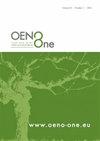Investigation of aroma carryover risk in a pilot plant and on industrial scale when bottling aromatised and subsequent regular wines on the same filling line
IF 2.2
3区 农林科学
Q3 FOOD SCIENCE & TECHNOLOGY
引用次数: 0
Abstract
Aromatised wine-based beverages and regular wines are commonly bottled on the same bottling line. Sealings installed in the bottling line absorb added aroma compounds from the aromatised wine-based beverages and a subsequent release of the absorbed aroma compounds from the sealings was monitored during cleaning sequences and in subsequent products. Such unintentional carryover is associated with the risk of violating the legal ban of any aromatisation of regular wine. If cleaning is carried out according to good manufacturing practice (GMP) and traces of aroma compounds in the subsequently bottled wine show no sensory significance, this unintended aroma carryover will be considered by the German Federal Ministry of Nutrition and Agriculture as technically unavoidable and has no legal consequences. The risk of aroma absorption and aroma carryover have been investigated in different foods (orange juice, milk, and wine) and simulated in model systems using a beaker, but no real bottling scenario had been investigated till now.To fill the knowledge gap we investigated the potential aroma carryover in a pilot plant, and in two different wineries during three bottlings of aromatised wine-based beverages and subsequent regular sparkling wine. Monitoring of installed sealings revealed the uptake of seven aroma compounds and further release of aroma compounds during a recommended cleaning sequence and subsequent contact with wine. A sensory significant aroma carryover into the subsequent wine that had been circulating for 24 hours in the pilot plant was observed only for α-ionone, which exceeded its odour detection threshold in white wine after 8 hours. Regarding the three bottlings of aromatised wine-based beverages and the subsequent sparkling wine, we recorded the uptake of γ-decalactone, eugenol, and trans-cinnamaldehyde in the sealings, and their further diminishment during the implemented cleaning of the wineries and subsequent bottling of a sparkling wine. During the short residence time of the product in the bottling line, no sensory and analytical differentiation of the pre-bottled and bottled sparkling wines was observed.在同一灌装线上灌装加香葡萄酒和随后的普通葡萄酒时,对试点工厂和工业规模的香气残留风险进行调查
芳香葡萄酒饮料和普通葡萄酒通常在同一条装瓶线上装瓶。装瓶生产线上安装的密封件会吸收加了香味的酒类饮料中的香味化合物,随后在清洗过程中和后续产品中会监测到密封件中被吸收的香味化合物的释放情况。这种无意的残留物有可能违反普通葡萄酒芳香化的法律禁令。如果清洗是按照良好生产规范(GMP)进行的,且随后装瓶的葡萄酒中的微量香气化合物在感官上没有任何意义,那么德国联邦营养与农业部将认为这种无意的香气携带在技术上是不可避免的,不会产生任何法律后果。为了填补知识空白,我们在一家试验工厂和两家不同的酿酒厂对三次装瓶芳香葡萄酒饮料和随后的普通气泡酒过程中的潜在芳香迁移进行了调查。对已安装的密封件进行监测后发现,在推荐的清洁程序和随后与葡萄酒接触的过程中,有七种香气化合物被吸收并进一步释放出来。只有 α-ionone 在试验工厂中循环 24 小时后,其香气才会明显转移到随后的葡萄酒中,8 小时后,α-ionone 在白葡萄酒中的气味超过了其检测阈值。关于三次装瓶的芳香化葡萄酒饮料和随后的起泡葡萄酒,我们记录了γ-癸内酯、丁香酚和反式肉桂醛在密封件中的吸收情况,以及在对酿酒车间进行清洁和随后装瓶起泡葡萄酒时它们的进一步减少情况。产品在灌装线上停留的时间很短,在感官和分析方面没有观察到预灌装和灌装气泡酒有任何区别。
本文章由计算机程序翻译,如有差异,请以英文原文为准。
求助全文
约1分钟内获得全文
求助全文
来源期刊

OENO One
Agricultural and Biological Sciences-Food Science
CiteScore
4.40
自引率
13.80%
发文量
85
审稿时长
13 weeks
期刊介绍:
OENO One is a peer-reviewed journal that publishes original research, reviews, mini-reviews, short communications, perspectives and spotlights in the areas of viticulture, grapevine physiology, genomics and genetics, oenology, winemaking technology and processes, wine chemistry and quality, analytical chemistry, microbiology, sensory and consumer sciences, safety and health. OENO One belongs to the International Viticulture and Enology Society - IVES, an academic association dedicated to viticulture and enology.
 求助内容:
求助内容: 应助结果提醒方式:
应助结果提醒方式:


